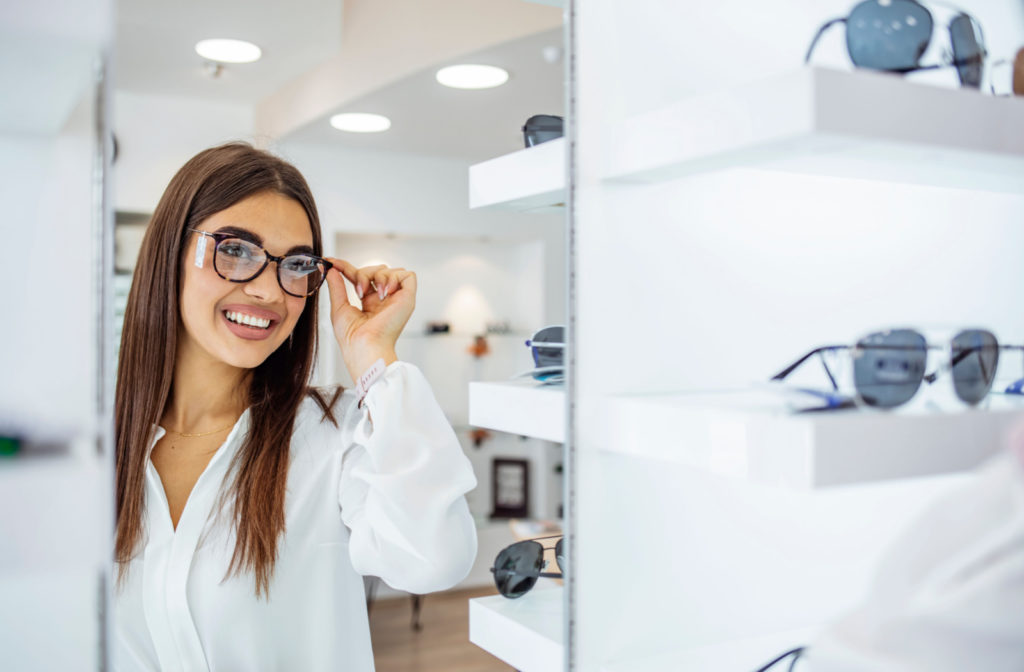Did you know that there’s a correct way to wear your glasses and sunglasses? That’s right! Rather than just slipping them on and starting your day, you should pay attention to how you wear your glasses–it can make all the difference.
We’ve all seen that character in the movies who is constantly pushing up their glasses. This is because they’re wearing their glasses incorrectly or wearing glasses that fit them poorly. Ideally, your glasses should sit high enough up on your nose to not slip off but low enough to not push into your brow or forehead.
Where your glasses sit on your nose affects more than just prescription glasses. If your sunglasses don’t sit correctly on your face, there can be some unintended consequences.
Finding the Right Glasses Fit
The most crucial consideration when finding the perfect pair of glasses is your comfort level with the frame. You should also be able to see clearly through the center of the lenses without any distortion.
The frames of your glasses should sit on the bridge of your nose without slipping or pinching. The arms of the glasses should fit securely around your ears without putting strain on them.
If the arch of your glasses is too narrow, they will pinch your nose and sit too high on your nose. If your glasses’ arch is too big, the frames will slip down your face.
Why Sunglasses That Fit Are Key
Sunglasses are beneficial to your health if they are worn correctly. Some UV rays are absorbed by the eyes, but not all. Anything that reduces UV exposure to the eye reduces risk.
When you’re wearing dark shades, your pupils will dilate as your eyes adjust to their surroundings; this expands the area where UV can reach the eye. You risk eye injury if your sunglasses are not resting on your face correctly, as the lenses cannot help block UV rays and may even refract them into the eyes.
Finding sunglasses that stay securely on your face and protect you from all angles is key to lowering your risk for sun-related eye issues.
How to Shop for Glasses
When you browse for your next pair of glasses, you should keep in mind that you’re not just shopping for glasses—you’re shopping to meet your medical needs, design, lifestyle, and budget.
Prescription glasses can be a worthwhile investment, but it’s important to be open about your budget with your optometrist, as they can help you find a pair that checks all the boxes within your budget.
Some questions you may have when shopping are:
- Which style is best for your face shape and line of work?
- Do you require any accessories?
- Do you require several pairs?
Finding the perfect pair of glasses at a reasonable price might take a while, especially if you’re new to glasses, but your optometrist is a valuable resource. You’ll want to find a pair that is lightweight and sits well on your face, as well as looks good with your features.

Selecting the Right Frames
Optometrists are here to help you find the best pair of glasses for you, so don’t hesitate to reach out and ask for assistance. These elements can influence your choice of glasses frames:
Your Face Shape
Beyond improved eyesight, appropriate glasses can enhance your facial characteristics and overall appearance. Choose a frame that matches your face to create a harmonious appearance.
The human face can be divided into various shapes:
- Square-shaped face: Wide angular jawline, broad forehead, and chin
- Round face: The length and width of the forehead, cheeks, and chin are comparable, with gentle cheekbones and jawline
- Heart-shaped face: Wide brow, thin chin, and pronounced cheekbones
- Diamond-shaped face: Narrow brow and chin, broad cheekbones, and big cheeks
- Oval-shaped face: Narrow brow and chin, high and broad cheekbones, and a gently curved jawline
- Triangle-shaped face: Narrow brow, wide jawline, and chin
Frames That Fit Your Personal Style
Once you’ve determined your face shape, shopping for frames that match you is the fun part! Here are some suggestions to help you get started:
- Heart and diamond faces should look for a pair of glasses that have similar angles. Rounder frames with a wider top than bottom should provide an interesting contrast.
- Round faces should choose frames that are wider versus tall. Rectangular frames add structure and lengthen the face.
- Square faces can be complemented by softer, wider frames to balance out the face’s sharp angles.
- Oval-shaped faces are complemented by practically every type of glasses. A pair with a firm frame but also a round bottom is the best bet.
Do Your Glasses Work for You?
If you’re new to glasses or have found that your current ones don’t feel good, you now, hopefully, have a better idea of how to shop for glasses that feel comfortable, practical, and stylish.
If you need assistance choosing the right pair, or you’re unsure where your glasses should sit on your nose for the most beneficial experience, book an appointment or drop by to see us at Total Vision Del Mar.



